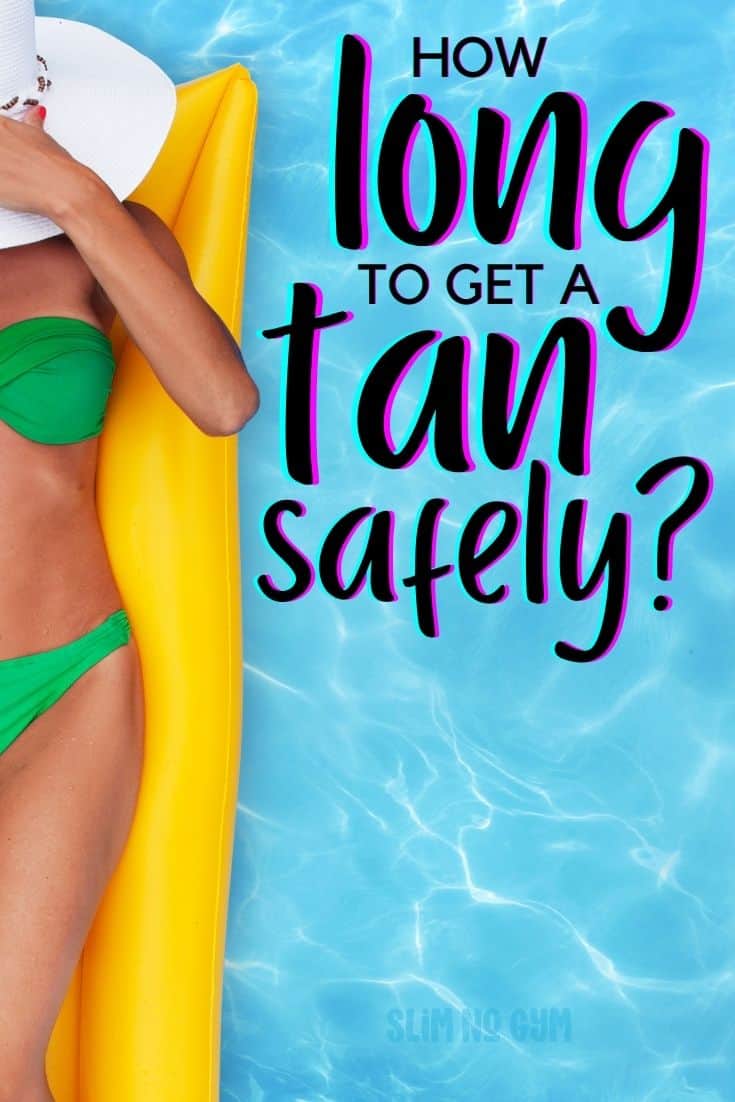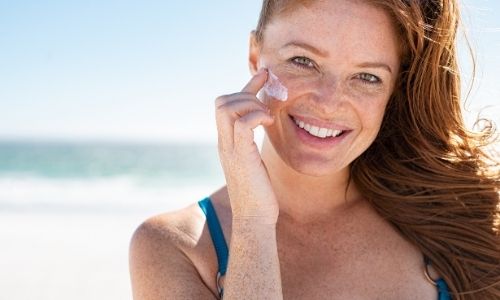
Raise your hand if you’ve ever gotten a tan so bad you looked as red as a Maine lobster?
No? Just me?
That happened to me at a Planet Fitness after they upgraded their tanning machines. I didn’t know they would be stronger and I came out RED.
Needless to say, the aloe and I were BFFs for the next week.
So, how long does it take to get a tan? And, how can you tan safely?
On average, it takes 1 to 2 hours to tan in the sun. Tans don’t immediately show up (and neither do burns), so you’ll have to be patient and stick to wearing sunscreen that’s 15 to 30 SPF. Tanning at any length does put you at risk for skin cancer from UV rays.
I’m committed to making sure you never get burnt again and walk away from the beach or your backyard with a gorgeous, glistening tan.
In this article, I’ll go over:
- 6 steps to getting a great tan
- How long to tan for
- How to build a dark tan
- How to tan faster
- What to do after a tan and how long they last
- If tan skin is attractive and why
Let’s get started!
Table of Contents
6 Easy Steps to Get a Great, Long-Lasting Tan
If only it were easy to get a long-lasting tan, the beauty industry would be making a killing.
The simple fact is that you CAN get a glowing tan if you know what to do.
Here are 6 steps to get a great tan:
- Choose the right time of day
- Apply sunscreen
- Tan for a limited period of time
- Avoid spending too much time in the water
- Try out a tanning diet
- Exfoliate first
Let’s explore these a little more!

1. Choose the Right Time of Day
You should know already how you tan.
Are you the person with pale skin who gets burned in 15 minutes or who can stay out for hours in the sun and not get a shade lighter?
The sun’s UV rays are strongest between 11 AM and 3 PM, which can make tanning and burning happen more quickly. If you’re concerned about burning, try early in the morning or later in the afternoon. If you tan well, try it when the sun is strongest.
The general policy is that you should tan for shorter periods of time and then increase the length after you know how your body behaves.
But, I’ll get into that later.
2. Apply Sunscreen

Regardless of how you tan, you NEED to wear sunscreen.
I can’t emphasize that enough.
You should put on sunscreen 20 to 30 minutes before going out to tan and then reapply every hour or two. Use a sunscreen that’s 15 to 30 SPF, depending on how much you typically burn.
If you spend a lot of time in the sun on a daily basis and don’t wear sunscreen, you should. There are moisturizers with sunscreen built in so you don’t expose yourself to more sun damage.
3. Tan for a Limited Period of Time
Tanning is kind of like exercising.
Don’t expect to run a marathon your first day of training. Similarly, you can’t tan for an hour on each side because your body will crisp up and burn.
If you’re new to tanning, you should tan on each side for 10 to 15 minutes until you begin to see a hint of bronze beginning to appear. Once you know how your body behaves, you can gradually increase the length in 5-minute increments.
Don’t treat your body like a piece of toast and only pull it out when it’s perfectly brown.
That’s a surefire way to get burned.
4. Avoid Spending Too Much Time in the Water

Do you know how if you wear black, you’ll feel hotter?
The same principle applies with tanning.
Water reflects the sun’s rays and you will burn if you stay in for a long time, regardless of the amount of sunscreen you put on.
It’s best practice to go into the water for short durations and then go back in the shade to rejuvenate.
I liken it to HIIT training.
5. Try Out a Tanning Diet
Believe it or not, there’s such a thing as a tanning diet.
Foods that are high in beta carotene and lycopene will give you a better tans.
That includes foods such as:
- Carrots
- Tomatoes
- Watermelon
- Guava
Research published in The Journal of Nutrition suggests that tomato paste can help naturally fight UV rays, but that it shouldn’t be used as a substitute for sunscreen.
6. Exfoliate First
Do you exfoliate? If not, you should.
When you exfoliate, you scrub off the layer of dead skin cells. Doing this before a tan ensures that your tan won’t flake off easily.
It also means that the tan will be absorbed more quickly, so keep that in mind when considering how long to tan.
When skin is sensitive (such as how yours is after exfoliating), it’s more prone to burn.
Consider exfoliating the night before tanning instead of the morning of.
How Long Should You Tan For?

That’s the million-dollar question, isn’t it?
In case you missed my answer above, here it is again.
On average, it takes 1 to 2 hours to tan in the sun. Tans don’t immediately show up (and neither do burns), so you’ll have to be patient and stick to wearing sunscreen that’s 15 to 30 SPF.
Here’s a helpful guide on how long to spend in the sun to get your daily Vitamin D (of which I’m chronically deficient).
It’s taken from researchers at the Polytechnic University of Valencia, who worked with people whose skin they considered “will tan easily, but still get burnt.”
How Long to Tan
| Season | Time in Sun to Get Vitamin D |
|---|---|
| Spring | 10 to 20 minutes |
| Summer | 10 to 20 minutes |
| Fall | 30 minutes |
| Winter | 150 minutes |
All this being said, you may have heard some rumors or gone down a Google rabbit hole to find out exactly how long you should tan for.
Let me clarify a couple of things:
- If you can get a tan in 2 days
- If 30 minutes is enough time in the sun to get a tan
If you have a question about how long to get a tan and it’s not answered, then drop it in the comments below and I’ll be sure to answer it.
Can You Get a Tan in 2 Days?
If you’re going for a really bronzed look, that may be something that’s a little hard to accomplish over the span of two days.
You can get a slightly bronzed look from tanning for a couple of hours over the span of two days, but for a really dark tan, that can take weeks to build up.
Tanning too much in a short period of time can cause skin damage and put you at a risk for skin cancer.
UV damage is serious.
Is 30 Minutes in the Sun Enough to Tan?
As I mentioned above, it is.
When you’re new to tanning, consider spending 15 to 30 minutes per side. That will give you a slightly bronzed look that show up soon after.
If you commit to spending 30 minutes tanning a few times per week, you can build a tan that will last.
If you spend longer, it will cause erythema, the fancy-schmancy name for sunburn.
Keep in mind that in the spring and summer, UV rays are at their strongest. You can spend longer in the sun during the fall and winter without as many adverse effects.
How Long Does it Take to Build a Tan?

There’s a common misconception that getting a base tan isn’t damaging in any way.
Any time you tan and expose yourself to the sun, the more UV radiation you’re exposed to.
Period.
According to the FDA, there is NO SUCH THING as a safe tan. Just keep that in mind.
But, if you’re going to build up a tan, you should do it in 15 to 30-minute increments over the span of a few weeks or months for a longer tan. If you’re going to a tanning professional, you can build up a tan over about 3 to 5 sessions, depending on the color you want.
Some of the risks of tanning include:
- Melanoma and other skin cancers
- Sunburn and heat rashes
- Premature skin aging
- Eye damage
- Dehydration
- Immune system suppression
The more that you tan, the more you’re increasing the risk of getting one of these unfortunate side effects.
How Long Does it Take to Get a Dark Tan?
If you’re trying to get a dark tan in one day, it’s nearly impossible.
To get a bronzed look, you should tan for about 1 to 2 hours a day, spread out throughout the day. If you want a darker tan, you should repeat that process over a few days, weeks, or months, depending on how much time you want and the color tan you want.
Here are some ways to maximize how dark a tan you can get:
- Protect your skin with a good SPF sunscreen (15 to 30 SPF)
- Change your position every 30 minutes
- Use accessories such as a reflective sheet or towel
- Reapply lotion every one to two hours
- Apply an aloe-based moisturizer afterward
The reason why people can get dark skin is because of melanin, which the skin produces. It will eventually change the color of your skin.
Regardless of how dark your skin is naturally, you can still get sunburned and sun damaged.
How Long to Tan Outside?
If you’re tanning outside, the same guidelines apply.
To tan outside, you should do so in increments of 15 to 30 minutes up to 1 or 2 hours in a day, provided they’re spread out. Make sure you use sunscreen and rotate your body throughout the day.
The last thing you want to do is end up like a rotisserie chicken, crispy on one side and not colored on the other side.
About Tanning Faster

You can only tan so fast in the sun.
Beyond that, you’ll need to use professional tanning services to achieve a quicker tan that may have some more permanence. But, be aware that it may come off as looking fake if it’s distant from your natural skin color.
You should know this alarming statistic, though…
According to research published in The Journal of Clinical and Aesthetic Dermatology, just 1 indoor tanning session can increase the risk of developing a melanoma (skin cancer) by 20%.
That’s scary!
Especially if skin cancer runs in your family.
An alternative to take is to get a spray tan or use self-tanners. While they may rub off more quickly, they aren’t as bad for your skin.
Be careful when trying to tan faster or you may cause irreparable damage to your body.
How Can I Tan Faster in the Sun?
To safely tan faster, you should consider the following guidelines:
- Use sunscreen of at least 30 SPF
- Rotate or change your positions frequently
- Eat foods that contain beta carotene and lycopene
- Try using oils like coconut and avocado that have naturally occurring SPF
- Don’t stay outside for longer than your skin can create melanin
- Wear a strapless top to ditch the tan lines
- Seek shade so your skin has time to recover
- Prep your skin by exfoliating
While doing these things doesn’t come with a guarantee you can tan faster, they should greatly increase your body’s ability to absorb a tan.
Keep in mind that doing these too aggressively can compound and cause your skin to burn.
Does Wet Skin Tan Faster?
Great question!
While spending too much time swimming in the ocean can cause you to burn because water is highly reflective, it’s not as reflective on you. In most cases, water droplets on your body will NOT cause you to tan faster unless the contact angle is really high.
If it’s a hot day out, you will dry your skin out, though.
And, dehydration is something you should be concerned about, especially if you sweat while tanning.
After Getting a Tan

Wondering what to do after getting a tan?
Here’s what you should know:
- How to make a tan last longer
- How long it takes for a tan to fade away completely
I mentioned earlier that you should exfoliate beforehand because your skin will absorb the tan better.
If you take a shower after going to the beach, be careful not to scrub away too much at your tan or it may disappear rather quickly.
A lot of the aftercare for a tan is going to depend on if you successfully tanned or if you got burned.
How to Make a Tan Last Longer
To make a tan last longer, you should consider the following:
- Apply a bronzer to keep the color
- Enhance your tan with self-tanning lotion
- Continue to spend time out in the sun to keep the tan
- Get a spray tan
For most people, a summer tan lasts for the summer. After the stay out of the sun, the tan will disappear.
So, to keep a tan that lasts a long time, the key is to continue to stay out in the sun.
Or, augment that with one of the products/services mentioned above.
How Long Does it Take for a Tan to Fade Completely?
This is one of the most popular questions I hear from tanning enthusiasts.
Everyone’s so eager to get a tan and enjoy it that they forget it does fade.
Essentially, your tan will begin to fade once you leave the sun or tanning bed, although you won’t notice it for a few days. But, if you’ve exfoliated before, that should prolong its life. Some people lose their tan over a week or two or over a few weeks.
The skin cycle lasts abut 28 days, so don’t expect to keep a tan for more than a month unless you’re renewing it by spending time out in the sun.
If you keep your skin moisturized and hydrated, that should keep your tanned skin from drying out and flaking off.
Is Tan Skin Beautiful? Why Tan Skin is Beautiful?

Many people associate tan skin with beauty, just like they do with how tall you are.
A lot of Hollywood actors and models get tanned for roles or red carpets, so it’s natural to think that you need a tan to feel pretty or attractive.
You don’t.
But, there is a bit of science behind the idea that tan skin makes you attractive, or at least in the eyes of people surveyed.
Research from Emory University says that people rated the tanned version of someone’s photo as twice as likely to be more attractive.
I think a lot of it at the end of the day has to do with tanned people feeling more self-confident. And, that certainly improves your likeability.
So, getting tanned won’t hurt your dating prospects. It’ll probably help them. There is something dreamy about sun-kissed skin.
Conclusion
I hope you feel more confident about tanning now than you did before.
In this article, I addressed the main question of how long it takes to get a tan. In case you missed my answer from above, here it is again.
On average, it takes 1 to 2 hours to tan in the sun. Tans don’t immediately show up (and neither do burns), so you’ll have to be patient and stick to wearing sunscreen that’s 15 to 30 SPF. Tanning at any length does put you at risk for skin cancer from UV rays.
I also went over:
- 6 steps to getting a great tan
- How long to tan for
- How to build a dark tan
- How to tan faster
- What to do after a tan and how long they last
- If tan skin is attractive and why
Do you have any questions about tanning? Can I help you feel more beautiful?
Let me know in the comments below.
To your tanning success!

